How to grow vegetables on straw
Straw remaining in the fields after harvesting is an excellent helper in our garden plots. The scope of its application is practically unlimited: it is an excellent fertilizer, and replacement for the soil, and a means for mulching the soil. How to use straw in the country, we will consider in this article.
The first use is mulching. What gives us mulching and why should it be done at all?
Mulching is a surface covered soil with mulching materials (straw, dry grass, leaves, and so on). With the correct conduct of this operation, the earth becomes loose, light, dries less in the summer.
What are the pros and cons of straw mulching?
Let's start with the pros: a dense crust does not form on the soil under a layer of mulching material, watering is less necessary for plants, since straw prevents evaporation of moisture from the surface, through a layer of mulch equal to 5 cm, annual weeds they do not make their way, that is, the overgrowing of the site is significantly reduced, the soil does not require loosening, water does not spray when watering, which excludes its getting on leaves and fruits, and the mulch also keeps the plant root system from overheating and frost.
The only negative is that this type of mulching reduces the amount of nitrogen in the soil, plants will not have enough of this substance for full development and nitrogen starvation may begin. To avoid this, it is enough to fertilize the soil with nitrogen fertilizers.
The best time for mulching with straw is spring. The peculiarity of straw is that it needs quite a lot of time to decay, so it is better to use it to mulch those plants that can be planted in cool soil. For example, potatoes, strawberries, cabbage, onions and so on. You need to mulch cucumbers with straw after the soil has warmed up enough.
How to mulch? Sprinkle the straw with an even layer, about 15 centimeters thick, in the places we need, around bushes and plants. Why is the layer so thick? The straw itself is voluminous and in a couple of days when it is caked, the layer will be no more than 4-5 centimeters.
Growing potatoes in straw
Recently, this method is becoming more common. Why? Firstly, growing potatoes in this way is not difficult. Secondly, a potato crop will definitely be good. Thirdly, potatoes will not need watering, while its roots and tubers will be constantly in conditions that are comfortable for them. Fourth, you can forget about weeds and the Colorado potato beetle, since it is difficult for weeds to break through a layer of straw, both different weeds and insects buried in the soil.
How to plant potatoes under a straw? We pre-prepared a bed (more precisely, a pre-designated place, since the place where we will plant potatoes does not require loosening or digging) is covered with a layer of peat. The layer thickness should be 15-20 centimeters. After that, we spread the seed potatoes on the “soil” as we like: in rows, in a checkerboard pattern, diagonally ... And we fall asleep all this with a thick layer of straw. After that, we carefully compact the straw, add more fresh straw, and so on, until the compacted straw layer reaches a thickness of 25-30 centimeters.
That's it, potatoes are planted. It remains only to observe the garden, waiting for first seedlings, then the crop. If the summer is very dry, then the bed will need to be watered 1-2 times per season.
In August-September, when it is time to harvest, you need to carefully remove the mulching layer and collect the potatoes. Harvest grown in this way is usually quite plentiful, all tubers are even, smooth, beautiful.
Experienced summer residents have long been convinced that straw can be an excellent alternative to ordinary soil, especially if there is no fertile soil on the site. Straw beds rid of weeds and do not require special care.
An unexpected move to a new residence sometimes breaks all plans. And even if a city dweller only dreams of a quiet and secluded place and a small garden - this is not always destined to come true. Something similar happened with our hero, who was forced to move out of town and wanted to break the beds "for himself", and when he arrived, instead of soil, he found a mixture of construction waste, concrete chips, a little sand and dirt on the site. But he did not give up and decided to make the garden out of "nothing."
The idea of \u200b\u200ba straw garden
The first thought of the unsuccessful gardener was the construction of high beds. But I had to refuse it, because its implementation required significant efforts. And suddenly our hero remembered a newspaper article read somewhere about straw bales and the successful experience of growing vegetables on them. Straw is an ideal container for plants. Hollow "tubes" perfectly absorb and retain moisture. By gradually decomposing, straw releases nutrients that are absorbed by young plants.
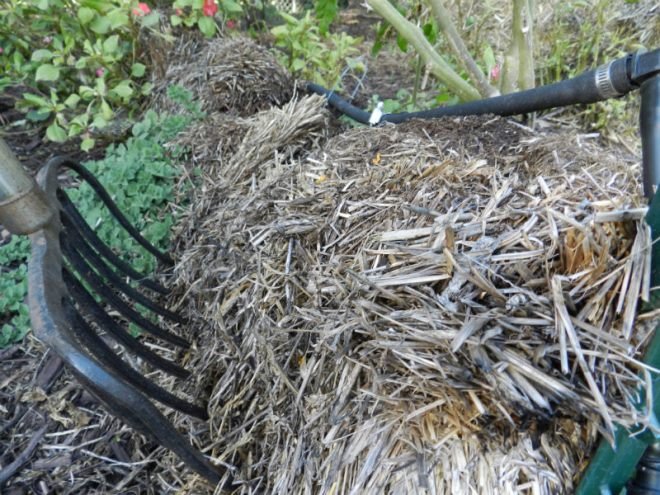
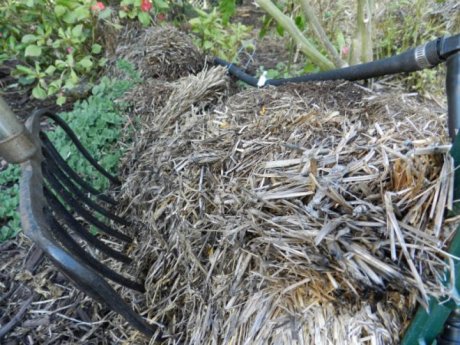
The advantage of straw beds is that they are given any shape, and bales can be laid on driveways, near household buildings and other empty places. The main condition is that the sun should fall on the straw for at least 6-8 hours a day. The straw base is widely used in the north, where summers are shorter and colder. The fact is that such beds are heated faster than the earth, stimulating the beginning of plant growth.
Organization of a straw bed
When creating a garden from straw, you can encounter a number of difficulties, but they are all overcome if you follow a few simple recommendations.
1. Find the "source" of good straw
Finding quality straw can take time. It is better to purchase it directly from the procurer, at the local peasant or farm. After all, sellers of garden centers are not always aware of the conditions under which straw was grown. The ideal time to buy is autumn. When creating the necessary conditions, straw bales are stored until spring, and then they can immediately be "put into action."
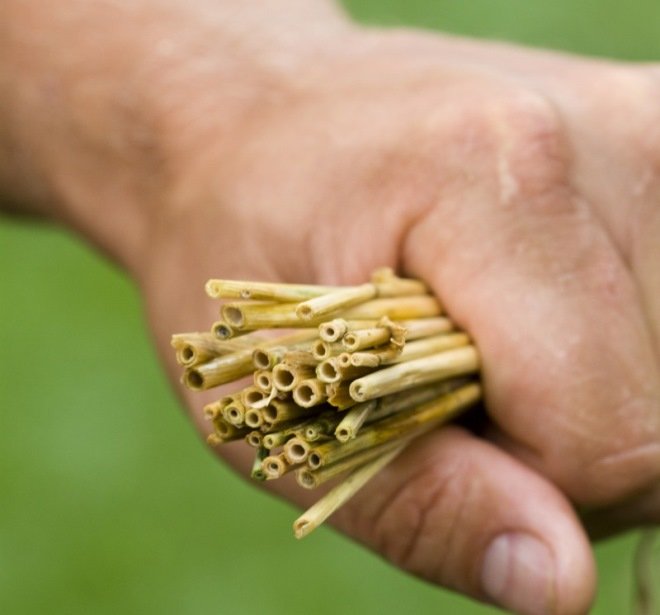
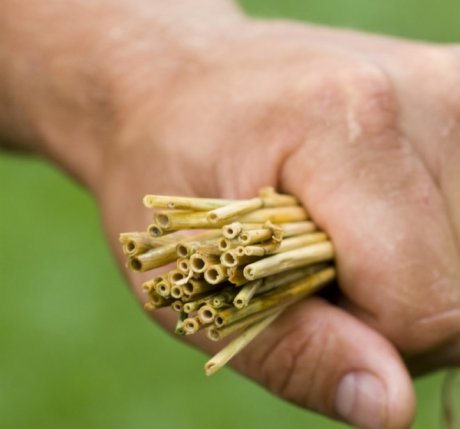
2. Choose a place to place your bales
Choose a place in your area where there is enough sunlight. Lay a thick cloth to prevent weeds from growing through the straw. Place bales of straw with the long narrow side up on the material. Do not remove the rope with which they are tied - it must maintain the shape of the bales, including when the straw begins to overheat.
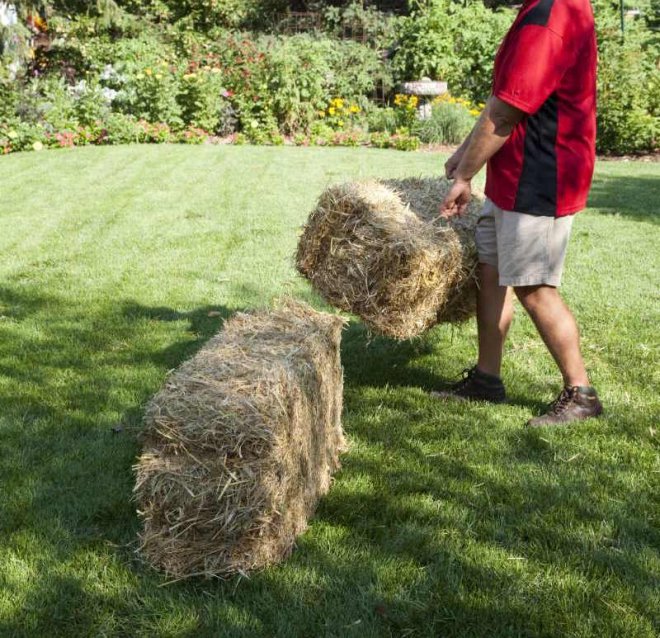
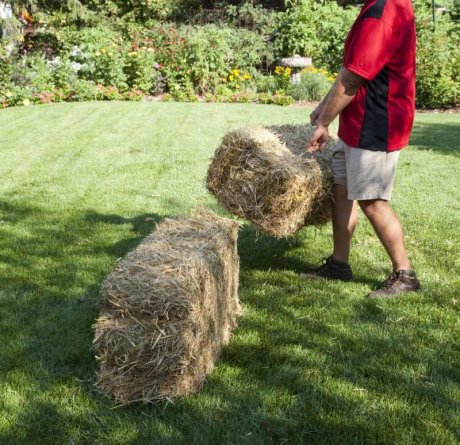
3. Prepare the straw for planting
Two weeks before the proposed planting, straw bales should be prepared. They need to be slightly watered and fertilized. About 10 days before planting, straw should be stamped. At the beginning of the week, add 700 g of organic fertilizer to each bunch and pour plenty of water so that the compost gets into the inner layers of straw. Then, closer to the weekend, moisten the straw bales again profusely. From day 7 to day 9, add 300 g of organic fertilizer to each bale every day and do not forget about watering. On day 10, add 500 g of phosphorus-potassium fertilizers (crushed fish bones mixed with wood ash in a ratio of 1: 1 are also suitable).


To understand that the “straw reactor” is working, put your finger inside the bale. It should be hot and humid. The formation of small black “fungi” similar to lumps of chernozem should also begin. This means that the "substrate" is ready for use, and germinating fungi will accompany your plants throughout the growing season. They will not harm the plants, but will serve as an indicator for you that the straw decomposes and feeds the crops planted in it.
4. Trellis and greenhouse - two in one
One of the best properties of straw beds is that they combine vertical gardening with a greenhouse "slope". Install two-meter supports at the end of each straw ridge and pull several rows of wire between them at a height of 20-25 cm from each other and from the base. As soon as the seeds give the first seedlings, the lower wire can be used as the basis for laying polyethylene. Pulling it like a tent, you will become the owner of an improvised greenhouse in case of cold nights. In the future, as it grows, it will be possible to tie cucumbers, zucchini, tomatoes and other vegetables to the trellis.
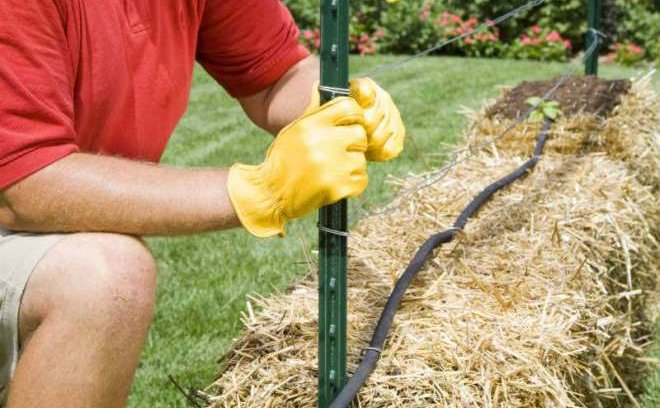

5. Landing time
If you will be planting in straw seedlings, use a spatula to spread it a little and make a cozy hole for the plant. Pour a slightly disinfected soil mixture into the hole so that it covers the roots of the plant. If you plan to sow seeds, pour a 5–7 cm layer of soil into each well. Initially, young plants will develop in the ground, and as they grow, their roots will go deeper into the straw base.
Today, straw as a fertilizer for the garden is used by many farmers.
Let's see what is straw and why is its use as so widespread?
Description and composition
Straw is dried stems without leaves and flowers. It is divided into subspecies depending on what straw is obtained from. We will not consider all species, but dwell on wheat, barley, oat and pea.
Wheat
Wheat belongs to the family of cereals and is one of the most important plants that are used for baking bread in many countries of the world. The chemical composition of wheat straw includes elements such as magnesium, iron, zinc, sodium, manganese, cobalt, as well as vitamin D and carotene. 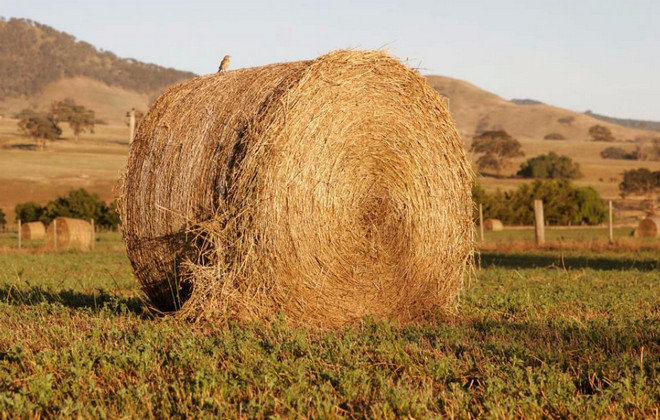 Also, the composition of wheat includes vitamins B1-B4, B6 and B9.
Also, the composition of wheat includes vitamins B1-B4, B6 and B9.
Barley
Dry stems of barley are rich in calcium, fiber, phosphorus, magnesium, iodine, iron and sodium. In addition, they have protein, lysine and biologically extracting substances.
Did you know? Vitamins and minerals found in barley are better absorbed than in the chemical counterpart.
Barley contains more protein. Barley culture is rich in vitamins such as D, A PP and E. 
Oatmeal
Oats are grown in many countries of the world both for and for human nutrition. Dry oat stalks contain many useful substances for the crop, such as protein, iron, cobalt, potassium, carotene and much more.
All these substances help plants to obtain the necessary amount of minerals, which are so necessary for the germination of a good crop. 
Pea
Therefore, it is better to use this dried grass to enrich the earth along with nitrogen fertilizers. The proportion is as follows: 10-12 kg per 1 ton of straw. To make this mixture decompose even faster, it is better to add to it.  At the same time, the activity of microorganisms increases, which means that the decomposition process will begin to proceed even more intensively.
At the same time, the activity of microorganisms increases, which means that the decomposition process will begin to proceed even more intensively.
To plants
The decomposition of dry grass has a bad effect on the root system of plants, since in this case formic, benzene, lactic, acetic and other acids enter the earth, which prevent the development of roots in plants.
However, when nitrogen is added to it, the negative effect on the plants is eliminated. Due to the large number of minerals, dry grass decomposes faster, since they are necessary for both microorganisms and higher plants.
Use of pure straw
Cattle are fed with dry herbs. Due to the fact that this product is non-nutritious, it is given as a top dressing. For better absorption, dry herbs are crushed, treated with chemicals (lime, ammonia, etc.) or steamed.
Granulation of straw along with artificially dried grass is also used.
Use dry plant stems for bedding.
They are also good for making mats and stoves.  In many museums in our country, straw is used to cover roofs (Pirogovo open-air museum in Kiev).
In many museums in our country, straw is used to cover roofs (Pirogovo open-air museum in Kiev).
Another use of dry stalks of cereals and legumes is biofuel. They are also pressed into pellets.
Sometimes straw is used to make paper (for example, banana). From it make baskets and nets.
In construction, straw is used to create straw blocks.
In addition, many fashionistas like to wear straw hats. Souvenirs are also made from straw. 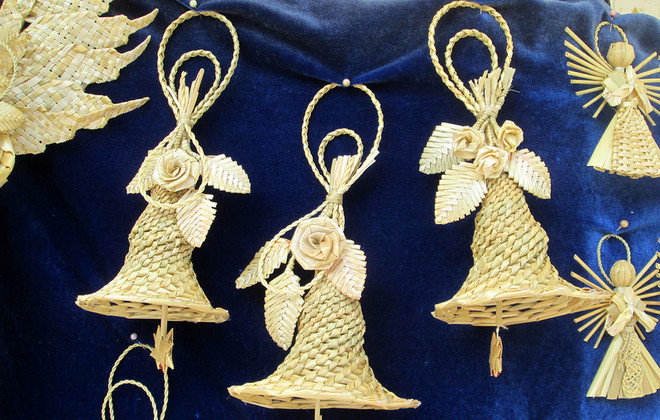 The use of straw is multifaceted, but we will focus on its use in the agricultural industry, that is, the creation of fertilizers from it.
The use of straw is multifaceted, but we will focus on its use in the agricultural industry, that is, the creation of fertilizers from it.
Straw fertilizer
Widely used is the use of straw as a fertilizer. Mulching means literally "shelter of the soil." This is done so that the earth does not overheat, and moisture remains on it.
Important!One of the main qualities of mulching with straw is the protection of plants from insects and diseases.
In addition, mulching reduces or even blocks weed growth. Also, mulch fertilizer increases the amount of organic matter in the soil. The structure of the soil improves, the earth becomes loose and soft.
Under the influence of the sun and rain, the earth loses a large amount of nutrients, and mulching prevents this. 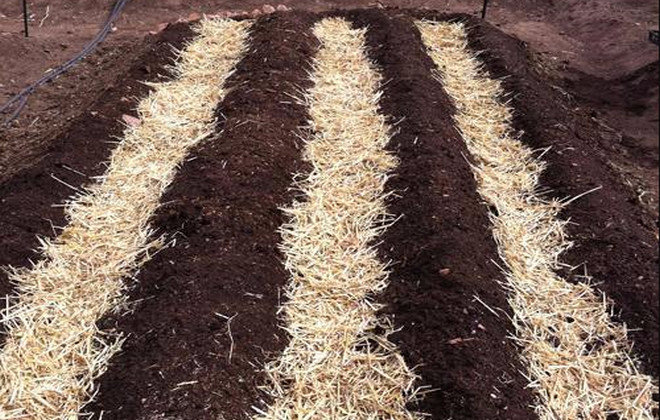 There is such a method: the use of dry grass as fertilizer.
There is such a method: the use of dry grass as fertilizer.
Before smelling the dried stems of legumes and cereals into the ground, they must be carefully ground. The desired length of crushed dried plants should not exceed 10 cm (75%) and 15 cm (not more than 5%).
Before making dry stalks of cereals and legumes, nitrogen is added. It is introduced in the form of green fertilizer or at the rate of 1 kg per 1 ha. After that, the dried grass is evenly scattered.It must be remembered that the height of the cut should not exceed 20 cm. Lay dry stems 12 cm deep. After some time, you need to deepen the dried grass into the ground, but you can’t do it right away, since it rots quite slowly.  That is why it is necessary to hold dried grass for some time buried in the soil.
That is why it is necessary to hold dried grass for some time buried in the soil.
Good crop results can be obtained by combining dry plants and sowing. After smelling dry grass, green manure is sown. This gives the soil an additional source of organic matter.
In addition, this fertilizer mineralizes the dry stalks of cereals and legumes, which will also affect the quality of the crop.
Important! The use of green mass and straw will favorably affect the yield of winter crops.
Advantages and disadvantages
And yet, let's figure it out: does straw in the garden benefit or harm? 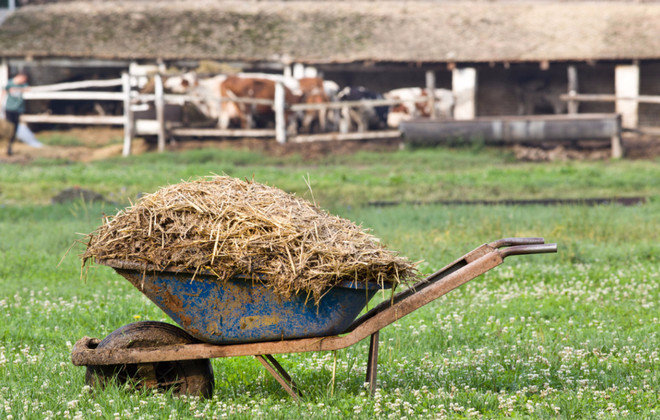
The benefits include:
- Accessibility - dried grass in itself is not of interest in the agricultural industry, therefore it is not used, but as a fertilizer it is simply irreplaceable.
- This fertilizer is nicer to use than manure.
- Less effort and time than other fertilizers (such as manure).
- Easy to store.
- A large number of organic substances.
- Increase in earth friability.
- Improving soil moisture permeability.
- Arable land holds water better, and with it beneficial substances.
- Dry grass contains vitamins physiologically active substances and amino acids.
- The carbon saturation of this fertilizer helps to “breathe” the earth.
- Decomposing, dry stems contribute additional carbon, due to which green plants grow.
- Protecting the earth from the sun.
- When using several types of straw, the number of trace elements increases, which contributes to the complete restoration of arable land.
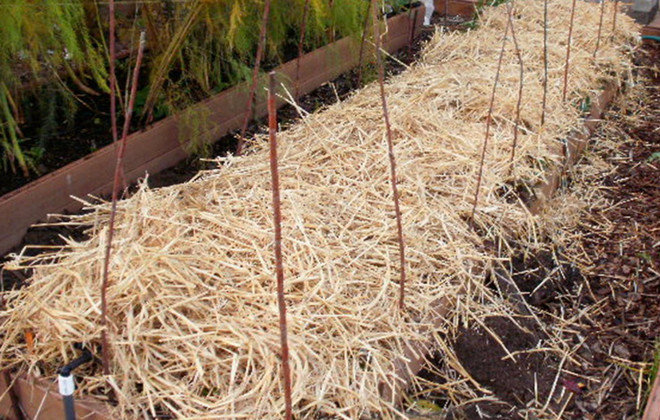
The negative sides of the use of this fertilizer:
- Fertilizers can get insects that adversely affect the development and germination of the crop.
- Decaying, the dry stalks of cereals and legumes turn into harmful acids for the development of the crop.
- Dry grass contains many organic compounds, for the decomposition of which you need a large amount of water.
- Dried stalks of cereals decompose slowly and because of this, beneficial substances will reach the plants for 3-5 years.
Did you know? In terms of organic matter, straw exceeds manure 3-4 times.
To prevent the negative effects of dried grass, you must:- Apply this fertilizer every year.
- Make dry stalks of cereal plants immediately after harvesting.
- After applying cereal fertilizers, it is best to plant legumes or row crops.
- Always know the measure of making dry grass.
- Grind the dried stems of plants and evenly distribute over the arable land, so it will rot faster and give more benefits.
- To add nitrogen and chernozem together with the dried grass stems, so that the rate of decomposition of straw will increase by 30%.
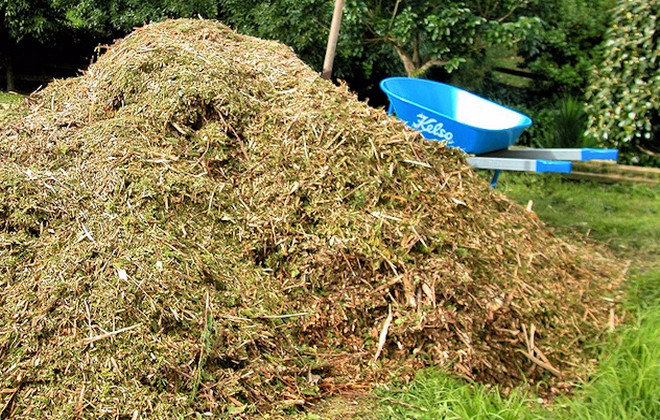 Be that as it may, but straw is a natural organic fertilizer for arable land that will make your crop rich and fertile soil for many years.
Be that as it may, but straw is a natural organic fertilizer for arable land that will make your crop rich and fertile soil for many years. Was this article helpful?
Well no
Can straw be used as fertilizer! It turns out, maybe! Straw can be planted in soil instead of fertilizer. Because it contains carbon, from which humus is formed. Also, straw is a source of carbon dioxide, which improves the conditions for air nutrition of plants.
It is best to apply straw to the soil in the fall, but you can use it in the spring with early incorporation. Substances in the straw will become available for plant nutrition only after complete mineralization. It was found that this process in plant residues, and in particular in straw, is activated when the ratio of carbon and nitrogen is more than 25: 1. Mineralization microorganisms absorb mineral soil for their vital functions. Part of it is fixed by these microorganisms, which leads to a decrease in this nutrient in the soil - and the plants experience nitrogen starvation. Therefore, when incorporating into the soil, it is recommended to add 8-12 kg of superphosphate and ammonium nitrate per ton of straw, or 8-12 g per 1 kg. In addition, it has been experimentally established that deep embedding of straw leads to the fact that the mineralization process takes place in the absence of air. As a result, toxic products are released that cause a decrease in yield.
The maximum decomposition rate of straw is observed by the 90th day of its mineralization, and it is much higher at a depth of 10-12 cm. Under industrial conditions, it is covered with discs, and after 2-3 weeks - with a plow. The application of mineral fertilizers increases the decomposition rate by 10-15%.
Straw can serve as a good mulching material that will preserve and retain moisture in the soil and save you from the tiresome weed control.
The fertilizer value of straw significantly increases pre-composting. For this, the usual one is used. The main components except straw are plant residues that stimulate microbiological processes and accelerate its mineralization. For 100 kg of straw, about 15 kg of green mass (mowed grass, weeds) is enough. Before laying in the straw, moisten with a solution of mineral fertilizers. In 20 liters of water, 2 kg of ammonium nitrate, 3 kg of potassium chloride and superphosphate are dissolved and consumed per 100 kg of straw.
With such components, the compost heap does without mixing. They are laid in alternating layers. Subject to regular hydration in a year, you will receive a beautiful one containing all the necessary elements for the growth and development of plants.


